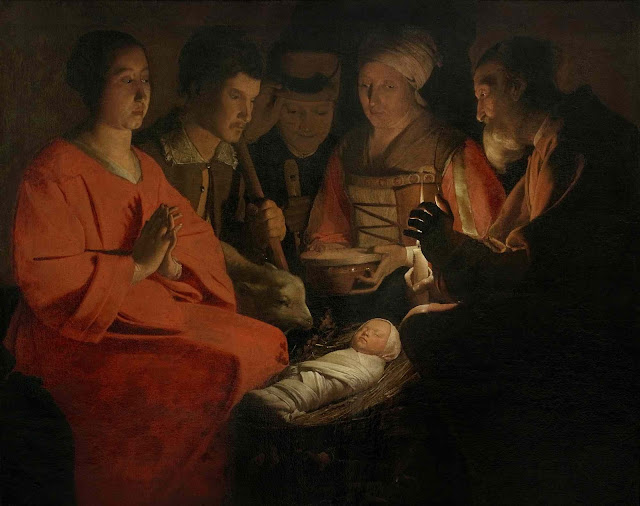| Georges de La Tour Peasant couple eating peas ca. 1620-25 oil on canvas Gemäldegalerie, Berlin |
 |
| Georges de La Tour Blind Musician ca. 1620-30 oil on canvas Prado, Madrid |
"Little is known of Georges de La Tour's life. By 1620 he was established at the prosperous town of Lunéville, where he specialized in religious and genre scenes. . . . La Tour's early mode typifies the Mannerist style of Nancy. By the 1620s, however, he had come into contact with the art of Caravaggio, probably through prints or paintings by northern artists such as Gerrit van Honthorst and Hendrick ter Brugghen. Lit by crisp daylight, La Tour's works from this period are characterized by their still atmosphere and meticulous rendering of ornament and textures.
Increasingly, La Tour was drawn to candlelight scenes in which a single flame created an atmosphere of otherworldly calm. He gradually simplified forms until, in his late works, all masses were reduced to simple, almost geometrical shapes. After his death, La Tour passed into virtual oblivion for almost three centuries. In 1915 a German scholar recognized La Tour's style in several pictures that had been variously ascribed to Spanish, Dutch, and other French artists."
– curator's notes from the Getty Museum
 |
| Georges de La Tour The Fortune Teller 1630s oil on canvas Metropolitan Museum of Art, New York |
 |
| Georges de La Tour The Cheat with the Ace of Clubs ca. 1630-34 oil on canvas Kimbell Art Museum, Fort Worth, Texas |
 |
| Georges de La Tour St Jerome 1630 35 oil on canvas Musée de Grenoble |
 |
| Georges de La Tour The Musicians' Brawl ca. 1635-40 oil on canvas Getty Museum, Los Angeles |
 |
| Georges de La Tour St Sebastian tended by St Irene ca. 1630-35 oil on canvas Kimbell Art Museum, Fort Worth, Texas |
"The style of Caravaggio admits of two different, one can almost say opposite, interpretations. Some of his followers, particularly the Neapolitans, emphasized the dramatic and horrific qualities in his painting, and adapted the manner to gruesome renderings of martyrdoms in which every unpleasant detail is recorded with fidelity and heightened by chiaroscuro. La Tour in his mature works seeks in Caravaggio exactly the opposite qualities. He does not imitate his rendering of detail, and he avoids depiction of the disagreeable details. Notice, for instance, that in the St Sebastian there is no blood and no anguish; the saint lies motionless and apparently dead, but with hardly a trace of his martyrdom. The forms are generalized to their greatest simplicity, and all violence, all movement even, are eliminated, so that the picture takes on a quality of stillness and of silence rarely to be found in the visual arts."
– Anthony Blunt, from Art and Architecture in France, 1500-1700, first published in 1953 as part of the Pelican History of Art, revised by Richard Beresford for the 5th edition, published by Yale University Press, 1999
 |
| Georges de La Tour Dream of St Joseph ca. 1630-45 oil on canvas Musée des Beaux-Arts de Nantes |
 |
| Georges de La Tour Penitent Magdalene ca. 1635-40 oil on canvas National Gallery of Art, Washington DC |
 |
| Georges de La Tour Penitent Magdalene ca. 1638-40 canvas Los Angeles County Museum of Art |
 |
| Georges de La Tour Penitent Magdalene ca. 1640 oil on canvas Metropolitan Museum of Art, New York |
 |
| Georges de La Tour The Newborn 1640s oil on canvas Musée des Beaux-Arts de Rennes |
 |
| Georges de La Tour St Joseph, carpenter 1640s oil on canvas Louvre |
 |
| Georges de La Tour Adoration of the Shepherds ca. 1645 canvas Louvre |
 |
| Georges de La Tour St Thomas before 1652 oil on canvas National Museum of Western Art, Tokyo |
"A certain number of artists were only rediscovered because of a memorable exhibition held in 1934, titled Les Peintures de la Réalité. No more eloquent rebuttal could be made of the mistaken idea that all seventeenth-century art involved classical idealization. It was crucial to recall the existence of an art attentive to everyday life, to poverty, care-worn faces, coarse delights, and humble apathy. Yet it is impossible to categorize such work as belonging either to the raw Caravaggism that was on the ascendant from Seville to the Netherlands, or to the bambocciate fashionable in France and Italy. They are, at best, an extension of those trends cast in another light, another nature, another perception – a transposition of familiar objects."
– André Chastel, from French Art: the Ancien Régime, 1620-1775, translated by Deke Dusinberre (Flammarion, 1996)